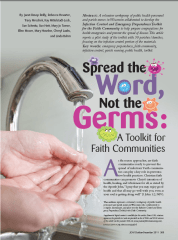‘Spread the Word, Not the Germs’ – Infection Control During Religious Gatherings
By Shawn Kennedy, MA, RN, AJN editor-in-chief
Last week there was a disconcerting report from the Associated Press about a Catholic clergyman in North Dakota who may have inadvertently exposed many members of his church to hepatitis A. According to the report, the ill bishop had probably contracted the illness from contaminated food while attending a conference in Italy and, because he didn’t immediately feel ill (incubation period usually ranges from two to four weeks, though can be as long as eight weeks), continued to dispense communion at several area churches.
According to the Centers for Disease Control and Prevention (CDC) Web page for hepatitis A, infection “is primarily transmitted by the fecal–oral route, by either person-to-person contact or consumption of contaminated food or water.” A person is infectious from two weeks before to one week after the onset of symptoms. The FAQ page on the site does say, in regards to infected food handlers (which would seem to fit this case, in that the bishop handled communion hosts), that “transmission to patrons is unlikely”—and also offers some guidance for postexposure prophylaxis (PEP). In this case, too much time had elapsed: PEP needs to be given within two weeks of exposure.
 This situation made me wonder, though, as we’re about to enter peak flu season, if there are any infection control guidelines appropriate for religious services. […]
This situation made me wonder, though, as we’re about to enter peak flu season, if there are any infection control guidelines appropriate for religious services. […]


